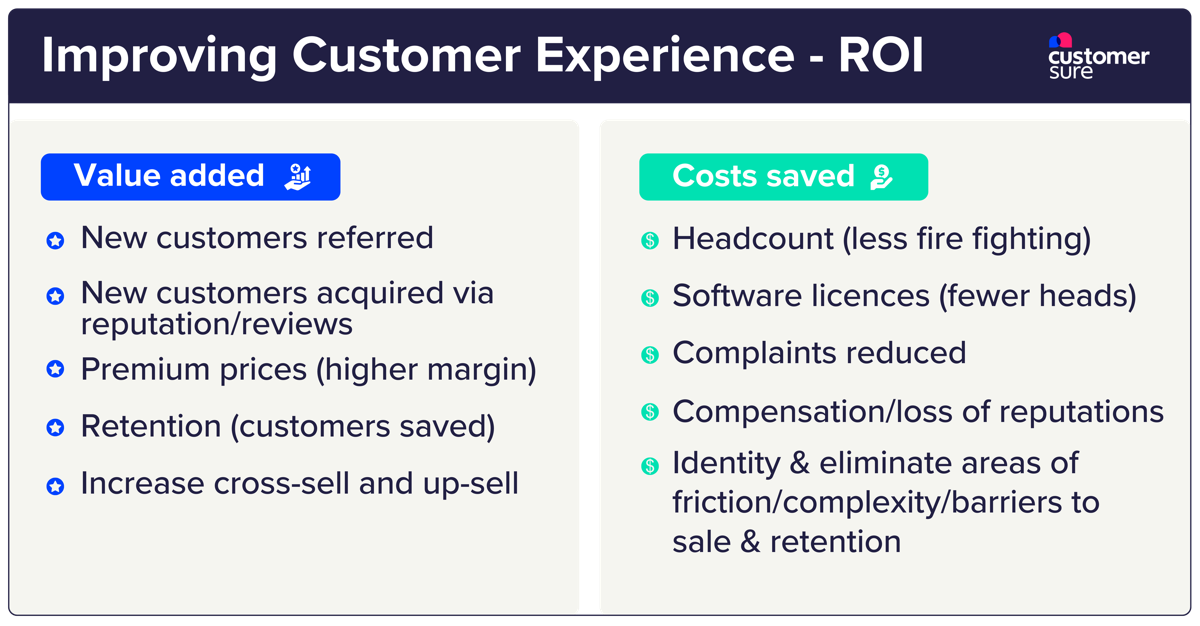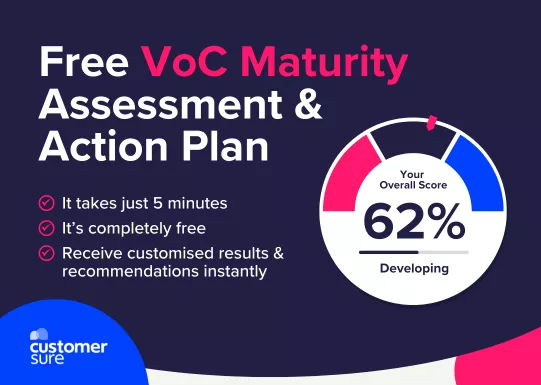

As we step into 2025, the world of Customer Experience (CX) continues to evolve rapidly. This post will tell you what’s working, what’s not, and why not.
It’s clear that huge investments are being made in CX, but customers aren’t feeling it – an influential report on the state of customer service across the UK revealed that customer satisfaction levels are at their lowest since 2010. Worse still, the trend is downward.
At CustomerSure, we help the firms who are bucking this trend; the firms who turn improved satisfaction into retention and growth. Let’s look at the trends these firms will be using to stay ahead of the CX curve in 2025, and more importantly, what you need to do to take advantage of them.
Gone are the days of one-size-fits-all customer interactions. Advanced data analytics and AI, or even just thoughtful use of CRM data, make it possible to deliver hyper-personalised experiences at the touchpoints which are most important to customers.
Whether it’s tailored product recommendations, forms that are pre-filled rather than blank, how-to guides that are context-sensitive rather than general, or customised survey follow-ups where you’ve taken the trouble to investigate that person’s prior contacts – personalisation makes customers more engaged and less frustrated, and this builds loyalty.
If you deal with customers online, there’s a security angle too. Scammers are more deceptive by the day. Personalised communications don’t solve the problem completely, but they can play a part in demonstrating authenticity and increasing trust.
It’s not hard to identify the areas where you can make improvements. Think about the ways in which you deal with customers, and start with those which are most urgent and important to customers. Look for ways to simplify and personalise. The best approach is always to be asking, “How would I want this to work if I was our customer?”
If you’re a CustomerSure client, you can personalise customer interactions based on real-time feedback. Tools like our survey personalisation feature ensure that every customer feels heard, driving satisfaction and trust.
According to PwC, AI is revolutionising customer experiences by enabling hyper-personalised interactions.
The sheer volume of customer feedback can overwhelm even the most dedicated CX teams. Even though analysing feedback for common themes, sentiment and root causes is immensely valuable, in the past most people have avoided it due to the volume of work needed to manually categorise each response.
Now, AI is sufficiently mature to eliminate the burden, providing sentiment analysis, automated categorisation and evidence-based insights. It can even suggest a checklist of corrective actions so you don’t miss anything.
It’s possible to use tools like ChatGPT for the analysis and get decent results. But a general purpose tool doesn’t entirely solve the problem because work’s still needed to train it to understand your industry sector, and expertise is required to sense check the results. Ideally you’ll use a Voice of the Customer platform with integrated AI features which removes the additional work.
CustomerSure’s platform has integrated AI features to streamline feedback management, helping CX teams uncover actionable insights effortlessly. By automating analysis, businesses can focus on implementing solutions rather than sifting through data.
Forrester predicts that AI will play a pivotal role in turning insights into action by the end of 2025.
If 2024 was a year when the importance of customer experience gained ground, then 2025 is the year when people understand that it’s not something you can bolt on, or delegate to a separate team. It’s a mindset that must permeate the entire organisation.
Whatever your marketing slogans, whatever posters you put on the office wall, customers can tell very easily whether the organisation and its people genuinely care about them, or whether it’s just lip service.
In 2025, embedding CX practices into everyday workflows will become increasingly important. From leadership to frontline teams, every employee has a role to play in delivering outstanding customer experiences because, whether directly or indirectly, everyone has an impact on customer experience.
It has to start at the very top, because that’s where the culture of an organisation is set. That’s the level from which people lower down learn what gets rewarded and what gets punished, and personal behaviours and language matter. You might have the most customer-centric mission statement in the world, but it can be destroyed in a moment by a casual comment which betrays an inauthentic attitude to customers.
There are two very simple measures you can introduce to help. One is to make sure earning customer retention through great service receives as much focus, investment and reward as winning new business. The second is to measure how satisfied customers are with the ease and speed of getting issues resolved. The bonus is that if you get these right, and your existing customers want to stay, then you’ll not only retain them, but it’s also more likely that they’ll have the confidence to refer others.
CustomerSure software channels relevant feedback to stakeholders, ensuring teams receive powerful, verbatim customer comments which help them do their jobs better. Explore our Voice of the Customer best practices to foster a culture of customer obsession.
Forrester highlights the importance of customer-centric cultures for sustained growth.
Customers increasingly expect businesses to anticipate their needs and resolve potential pain points before they surface. Proactive CX management uses customer data to identify trends and address issues early.
This initiative builds on the AI-powered feedback analysis described above, and also on the traditional use of satisfaction scores, because analysis is only part of the solution – the needles on the business KPIs won’t even flicker until analysis translates into action. The score tells you there’s a problem, the analysis tells you what needs fixing, and the action improves customer experience.
It will feel odd at first, but you should embrace any low satisfaction scores. These are the early warning signals that help you nip problems in the bud. Low scores identify customers who are at risk while they want to be saved and while there’s still time. Low scores help you identify areas of friction or waste in business processes, so you can fix them – saving customers and reducing the cost of errors and waste.
Obviously you’re not aiming for low scores and they should be the exception but, simply put, and when they happen, low scores make you more money than high scores.
Start with a different attitude to low scores! Instead of brushing them under the rug, make every piece of tough feedback a stepping stone to exceptional service.
With CustomerSure, businesses can leverage feedback trends to anticipate challenges and implement proactive solutions. Visit our working together page to see how we support proactive experience management.
According to Gartner, proactive service solutions will significantly improve customer retention.
Popular opinion would have you believe that it’s hard to measure the ROI of CX initiatives. That’s simply not true.
Improving customer experience adds tangible, financial value to the organisation in many ways by increasing revenue and reducing costs.
The illustration below shows a few examples of how more hard cash comes in, and less real cost goes out:

This makes financial metrics like Customer Retention Rate (CRR) and satisfaction metrics like Net Promoter Score (NPS) more useful than ever, when used correctly.
Set targets for improvement. Not targets for improving satisfaction scores or NPS – these are useful proxies to measure, but they make poor targets. Instead set targets for improving specific aspects of your business that are most important to your customers, such as quality (of your products or services), first time issue resolution, and how easy you are to deal with.
CustomerSure offers insights and tools to link CX investments with tangible business outcomes.
Discover how to measure the ROI of CX in our webinars and guides.
Data privacy regulations and the growing emphasis on ethical AI adoption are reshaping how businesses handle customer data.
Transparency and compliance are essential for trust, but they’re moving targets. While GDPR and data protection legislation is generally well understood, managing data in an AI context is a new challenge.
One of the key considerations is whether your data is accumulated by the AI tool you’re using to improve its training. If you can guarantee the data contains no personally identifiable information, and you have permission from customers to use it in that way, you may consider the benefits of sharing are worth it. But that’s a significant risk, and in general you’ll want to make sure that the data is not absorbed in that way.
Completely avoiding AI due to caution means missing out on its benefits. AI can save time and analyse data effectively. As long as the tools don’t store your data, you can safely take advantage of these capabilities.
CustomerSure ensures that businesses remain compliant while gaining actionable insights. Learn how we support GDPR-compliant surveys to safeguard customer trust.
PwC highlights the importance of responsible AI adoption in enhancing CX.
It’s important to be aware of the trends and innovations in customer experience. Anything that helps you do more with less is a good thing.
On the other hand, don’t be seduced by the latest shiny thing. Be especially wary of persuasive claims by technology vendors – are they working to benefit your customers, or just their investors?
Always remember that although customers’ expectations do evolve, the fundamentals never change. People want good quality products and services delivered by authentic, friendly people with fair and transparent commercial terms. They require good communication, and should anything go wrong, they want it to be easy and fast to raise and resolve issues.
In most organisations there is much unfinished business in these areas, and the greatest gains may be in the most obvious areas.
At CustomerSure we’re a leader in customer experience management know-how, with a software platform that embodies all the best practices. Get a no-obligation (and no hard-sell!) review of the simple steps you could take to improve – book a discovery call now.
This guide is also available in video form on our YouTube channel.

Gain a clear view of how mature your VoC programme is, and receive tailored recommendations to take it to the next level.
Take the assessment »Connect with a CX expert who’ll help determine your current VoC programme maturity level and provide a 3-step action plan to improve.